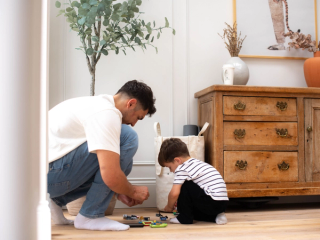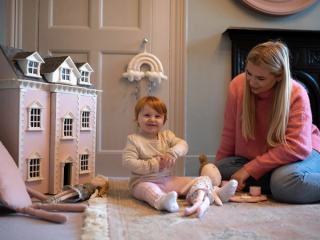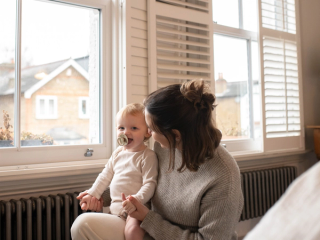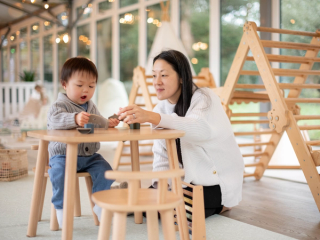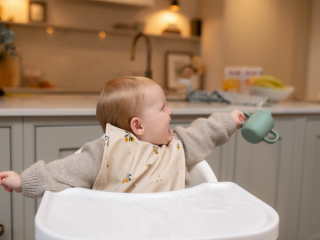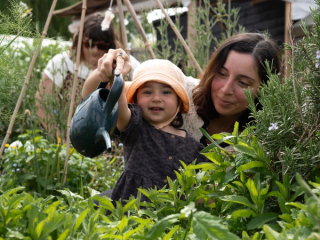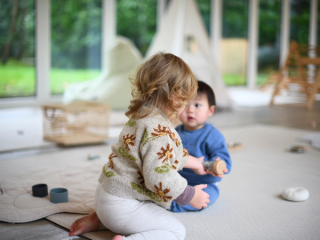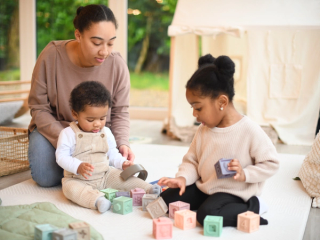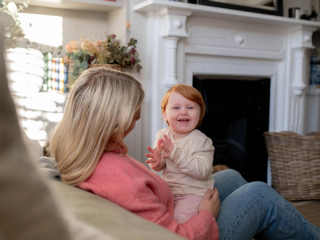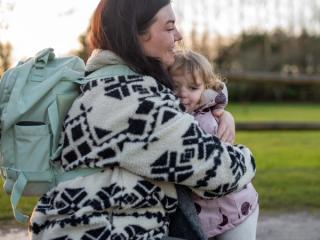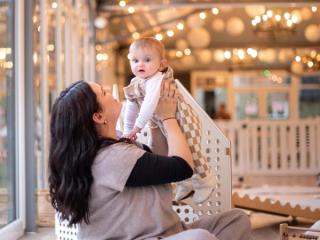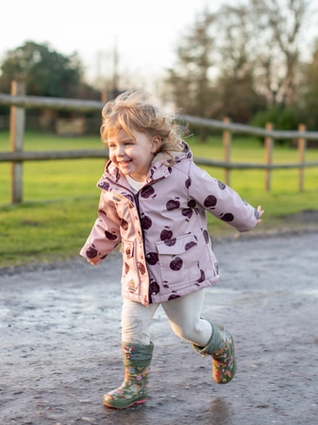
- Home
- Advice Hub
- Toddler
- Toddler Milestones
- Fostering Independence
Fostering independence: encouraging small steps towards big growth
Support your toddler’s growing independence with confidence and care. Discover practical tips, scripts, and science-backed strategies to build resilience, decision-making skills, and emotional security - one small step at a time.
From the moment toddlers insist on fastening their own shoes (even backwards!) to the determined “I do it!” cries at breakfast, fostering independence can feel exhilarating and exhausting all at the same time.
But here’s the thing, independence isn’t about leaving our little ones to figure it all out alone. It’s about offering safe, scaffolded opportunities for them to try, to learn, and to shine.We can only set them up for success when we provide support through connection, encouragement, and a sprinkle (or huge bucket load) of patience.
At The Behaviour Bank, we support parents in guiding independence in a way that builds resilience, trust, and genuine confidence. Together, let’s explore how small, intentional steps today can lay the foundation for capable, confident futures.
Developmental not defiance
Science tells us that between birth and age five, children's brains experience rapid synaptic growth (connection building), particularly in areas governing executive function - planning, focus, and decision-making. However, these pathways are immature, meaning toddlers want to do it themselves, but can't always predict consequences or manage their emotions.
Their cries for independence aren’t rebellion. They are their brains urging: "Let me learn."
When we respond with support instead of resistance, we help wire the skills of self-management, problem-solving, and emotional strength.
Here are some TBBS top tips to support those mini moments of Independence. Let’s start with dressing and self-care.
- Start by laying the Foundations: Place socks and shoes at their level for easy access.
- Be sure to map the journey: Start with manageable tasks, like pulling up trousers or zipping halfway.
- Celebrate together as you cheer effort: “You slid your socks on by yourself! That was tricky, and you kept trying!”
Next up, let's navigate the formidable food and mealtimes. Often used to seek high levels of control, mealtimes can be a great place to increase independence.
- Get them involved by offering them mini responsibilities: Let them butter toast with a child-safe spreader.
- Give them the opportunity to gauge how much and of what they can eat by allowing them to serve themselves. Provide a tray with snack choices they can assemble themselves (fruit slices, crackers, cheese).
- Keep the momentum through the use of micro choices and empowerment phrases: “Which bowl would you like for your cereal today?
As children watch us around the house, they can feel the urge to get involved. This is a wonderful opportunity to support independence and also train them up as household contributions - which might serve us well over the years to come!
- Start with the little jobs: Watering the plants with a small jug or help match socks from the laundry pile.
- Strive to make it playful: Set a ‘race against the clock’ for tidying or a ‘matching game’ when sorting utensils.
- Remember to value their contribution: We all want to feel seen and heard, even as toddlers. Model gratitude and appreciation - a perfect way to encourage great phrases such as ‘thank you’.
Words matter! What we say has a huge impact on our children, not only in the moment but for years to come. We are quite literally building their inner voice with the things we say to, and around, them. Here are some balanced scripts that will help you develop your child’s inner coach rather than their inner critic.
Instead of: “Here, let me do it – it’s quicker.”
Try: “You’re learning something new – let’s work it out together.”
Instead of: “You’re making a mess!”
Try: “Learning can get a little messy! Look at all the exploring you're doing.”
Script Boosters:
“You gave it your best – that’s real effort!”
“I love how you’re thinking about how to do it.”
Flexibility: The backbone of encouraging independence
Science tells us that young children thrive on predictability, but rigid systems can stifle growth. Offering structured choices within a clear framework gives toddlers the freedom they crave, with the security they need.
With this in mind you can try using simple visual schedules to support routines and daily life such as pictures of brushing teeth, putting on shoes, grabbing the coat.
You can also try limit or micro choices, this is where you focus on giving the children more autonomy. It might sound something like, “Would you like the yellow cup or the blue one?”. However, too many options overwhelm the brain’s developing decision-making centres so avoid listing options beyond two or three.
And finally, leaning into a balance of choice and structure is key: “First we tidy up, then you choose a book for story time.” We want children to feel safe within a boundary whilst feeling confident in their independence.
Embracing “I Do It Myself” moments (even when it's slower)
Time pressures are real. We’ve all stood by as tiny hands battle with coat zips while the minutes tick away. However, slowing down now builds self-belief that lasts a lifetime.That patience is a virtue my friends! But what does this look like practically?
Here are three TBBS strategies to help you slow down and support your child.
The Positive Pause: Before stepping in, silently count to 10. This gives your brain time to regulate and decide how best to move forwards in the moment. ‘The Positive Pause’ strategy is possibly one of the most impactful yet overlooked strategies in the bank!
The Strengths Spotlight: Notice what they can do first before offering help. This adds to that inner coach and gives them a sense of achievement that fuels their momentum.Children need to feel they are on ‘the right track’, just like grown ups
Guided Support: Ask before you jump in and take over. Children respond well when they feel in control. So a simple, “Would you like me to hold the zip while you pull?” can change the direction entirely.
Amazing strategies shared, we all know things don’t always go to plan. There will always be times that our children just can’t do something, or are too tired, too hungry, too frustrated. So, you might want to pop this phrase into your back pocket for those more challenging times - “It’s okay to feel stuck. We can figure it out together.” Let’s be on their team during those tough times.
Safe boundaries build true independence
Independence without boundaries feels like chaos to little brains. Clear, kind limits allow them to explore safely, knowing you are their anchor. Ashave shared in other articles - boundaries truly make all the difference for our children. Don’t forget to lead with that YES!
Try this on for size…
“Yes, you are a great climber. You can climb the small steps here, but not the high wall.”
“Yes, you can choose which shoes to wear, but we need them on before we go outside.”
Science tells us that predictable boundaries support emotional regulation by reducing cortisol (stress hormone) spikes, fostering a calmer, more confident child. It might feel strange to begin with, but practice makes progress. The more we support our children with a yes, the more we keep connections in place and allow them the space they need to stay emotionally regulated.
A balanced approach: independence as a lifelong gift
Encouraging independence doesn’t mean stepping back and letting go. It means leaning in and supporting the try, the wobble, and the triumph.
At The Behaviour Bank, we believe that independence grows best when it is watered with connection, patience, and trust.
It’s not about doing it for them.
It’s not about doing it without them.
It’s about doing it with them.
Five quick TBBS takeaways to start the journey of independence for your little one.
- Choice builds confidence: small decisions lead to big thinking.
- Struggle isn’t failure: it’s where growth happens.
- Celebrate effort: "You kept trying!" means more than "You got it right!"
- Visual cues empower: they make independence visible and achievable.
- Stay present: Independence blooms best from a foundation of love and security.
When we nurture these small steps today, we raise resilient, capable adults for tomorrow.
For even more practical strategies, confidence-boosting scripts, and science-backed support, visit The Behaviour Bank™, your trusted resource for creating connected, capable families.
Advice & tips

Want to read more? Join the HiPP BabyClub for full access to this article.
As a BabyClub member, you'll get access to a range of exclusive benefits, including:
Monthly competitions
Discounts from our Partners
Expert advice tailored to your little one's age
Weaning recipes
HiPP shop discounts*
*10% off HiPP's online shop does not apply to our First Infant, Anti-Reflux or Comfort Formula Milk.
Important notice: Breastfeeding is best. Follow on milk should only be used as part of a mixed diet from 6 months. Talk to a healthcare professional.




